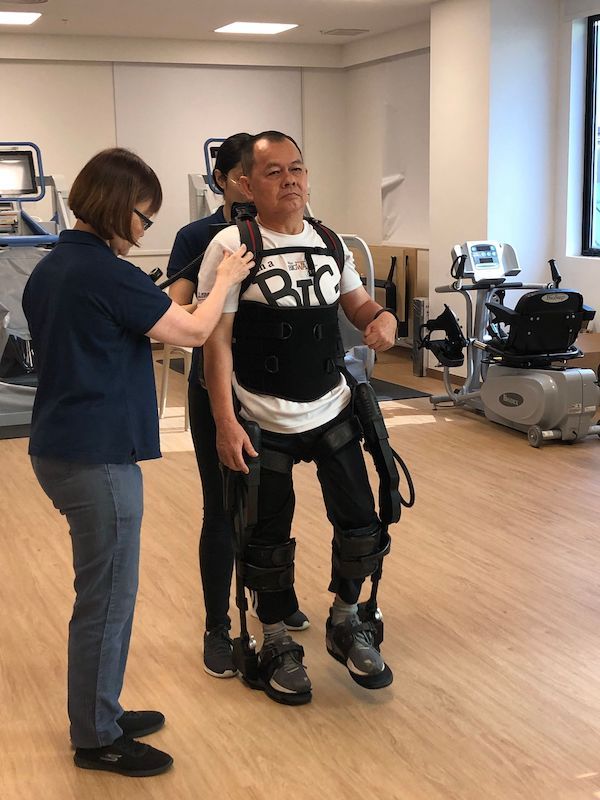How Technology is Transforming Stroke Rehabilitation in Singapore

Stroke recovery and rehabilitation have come a long way in the past decade. With advancements in medical technology, machine-assisted therapy has emerged to supplement stroke recovery rehabilitation in Singapore. Find out how Stroke Support Station (S3) is reinventing rehabilitation with technology to help stroke survivors and caregivers in our community.
Understanding Stroke, Survivors' & Caregivers' Needs
A stroke occurs when the blood supply to the brain is interrupted or reduced. The effects of a stroke vary for each individual as it depends on the area of the brain that is affected. The post-stroke recovery process is also dependent on the ability of the brain to heal through neuroplasticity (where brain cells regenerate and rewire neural connections). This is where physical, occupational, and speech therapies come in to improve stroke survivors’ motor skills. These therapies often result in rehabilitation being a labour-intensive process.
At the same time, caregivers may lack knowledge of how to care for stroke survivors. Survivors themselves struggle to sustain their confidence and motivation to recover. Mobility and financial issues are common factors that prevent stroke survivors from seeking treatment as well.
Kick-starting Stroke Recovery with Technology
S3 aims to provide a holistic rehabilitation regimen that allows stroke survivors to regain mobility at an affordable cost. This is so survivors can better re-integrate into society in less time and with less financial burden.
As each recovery journey is unique, S3’s rehabilitation solution for improving mobility is made up of conventional and machine-assisted therapies. Conventional therapies are done once or twice a week, while programmes with machines are done at least twice or thrice a week.
- A partnership with BODYENGINEERING
To seek out innovative means for improving motor function in stroke patients, S3 partnered with BODYENGINEERING (a company specialising in rehabilitation technology) in 2017 to pilot their Walk-On System.
This system comprises a suite of equipment including anti-gravity treadmills (AlterG®), Robowalk®, Biostep and an integrated tracking system. With these equipment, therapists can measure improvements in mobility and gait efficiently, and also encourage patient independence. In addition, the safety features and support system within the machines allow for greater confidence in clients when attempting more challenging tasks, while ensuring safety and reducing the labour-intensity for therapists for high repetition tasks.
The pilot project proved successful, and in July 2019, S3 tapped on Community Silver Trust (CST) to purchase the Walk-On systems to extend their holistic rehabilitation programmes to their centres in Enabling Village and Jurong Point Shopping Centre.
- Joining the Improving Mobility via Exoskeletons (iMOVE) Project

In 2019, S3 joined the Improving Mobility via Exoskeletons (iMOVE) project funded by Temasek and Trailblazer foundations. An exoskeleton is a robotic device designed to promote proper posture and natural gait for severely impaired stroke survivors to improve their mobility. This assistive device allows therapists to train clients who are unable to walk, to progress to a stage where they are able to make use of the Walk-On system. From there, clients are able to build endurance and regain sufficient mobility to walk at least a few hundred metres.
Through this project, S3 was given the opportunity to utilise an exoskeleton for two days a week (to be increased to five days a week by late-October). With the help of the CST funding, S3 acquired one exoskeleton in 2019 to be used across both centres.
Surviving All Odds
John Seah, an S3 client, experienced four strokes within a decade but that didn’t stop him from trying to get better. He believes that getting better is a personal decision, and that stroke survivors need to have the drive to recover. Through the practices and techniques learnt from his rehabilitation sessions at S3, John has seen his hard work pay off. With S3’s customised treatment programme, he is now able to run short distances!
“I want to motivate other stroke survivors who are going through the same journey. It is not easy, but with hard work and perseverance, all of us can get off the wheelchair and run at our own pace!”
- John Seah, 60
Stroke Survivor
The Continuum of Recovery
By combining the use of technology with conventional therapy, S3 aims to provide stroke survivors the best possible chances of recovery. All machine-assisted therapies are priced at the same rate as conventional therapy. A fully subsidised patient can receive an hour of rehabilitation with the exo-skeleton or anti-gravity treadmill at a price of $10-$12. S3 also has financial assistance schemes in place for clients who need further support.
